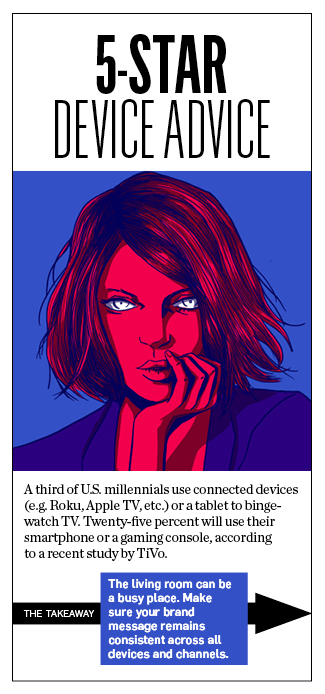Remember when binge watching was an indulgence reserved for a sick day or snowstorm? Well, those days are over. A recent study revealed that almost a third of U.S. consumers binge-watch TV shows on a weekly basis. And we’re talking full-fledged binging here, with 70 percent of people viewing an average of five episodes per sitting.
Binge watching is officially the norm, and it is transforming the way marketers approach customer experiences. This “binge effect” means users expect to pause a show on one device and pick it up in the same place on a different device, not to mention having constant access to a wealth of quality content. And it’s not just TV viewing. Consumers are increasingly frustrated when their devices don’t sync automatically.

Considering how often consumers switch devices throughout the day, it’s not surprising that brands are now also striving for seamless, cross-device experiences. BuzzFeed’s latest offering, Swarm, is a good example of where the industry is headed. With Swarm, advertisers can simultaneously run campaigns across all of BuzzFeed’s mobile and web properties—not to mention six of its top social platforms—Facebook, Snapchat Discover, Vine, YouTube, Tumblr and Instagram.
The secret to Swarm’s success isn’t simply that BuzzFeed’s advertisers can now reach BuzzFeed readers on whatever device or platform they’re using. It’s also that BuzzFeed can sync advertiser messaging across all those devices and platforms to make the biggest possible impact. As BuzzFeed marketing chief Frank Cooper explains it, Swarm is a “cross-platform strategy that’s designed to light up our entire network in a big, coordinated post.”
This is great for brands partnering with BuzzFeed, but it doesn’t answer how everyone will deliver great customer experiences. The good news is that technology and data companies are solving these cross-device problems in creative ways. Adobe Marketing Cloud recently debuted the Device Co-op, a network that lets brands work together in identifying consumers across digital touch points.
It’s been estimated that the Co-op will link up to 1.2 billion devices, and will use “cryptographically hashed login IDs” to protect the consumer’s privacy. It also has the advantage over Facebook and Google of not putting advertisers into walled gardens where they can use some products but not others.
For some brands, seamless experiences might come down to targeting the right banner ads to the right devices. For other brands, it might mean creating immersive experiences that take advantage of each device’s unique features. After all, it’s early days, and a great cross-device experience will mean different things to different companies. In the meantime, however, one thing is clear: Brands and media companies that aren’t looking for new solutions may soon be hearing from some very unhappy customers.









